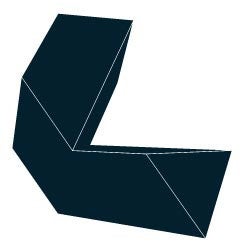Tony Smith worked as an architect before he became a sculptor. He believed that simple geometric shapes could be very expressive. This sculpture is made of simple geometric shapes that the artist combined to make a complex form. As you walk in a circle around the sculpture, see how different geometric shapes become noticeable on each side.
What shapes can you identify in the sculpture?
How would this sculpture be different if it were brightly colored instead of all black?
What does this sculpture remind you of? The artist titled the work Amaryllis after a flower.
On light cardboard, like that from a cereal box, draw a variety of geometric shapes in different sizes. When you have approximately ten different triangles, circles, squares, rectangles, and polygons in different sizes, cut them out from the cardboard. Using tape, experiment with attaching the shapes together in different ways until you make a 3D form. Can you make familiar shapes, like a pyramid? See if you can make a multisided form like the sculpture.
3D —Having three dimensions or sides (length, width, and height)
Form —The shape of something, as opposed to its surface
Geometric —Using simple shapes and elements such as lines, circles, squares, and triangles
Model —A small version of a large thing
Pentagon —A shape with five sides
Polygon —Any shape made of connected lines, such as a triangle, square, or pentagon
Sculpture —A work of art that has height, width, and depth

